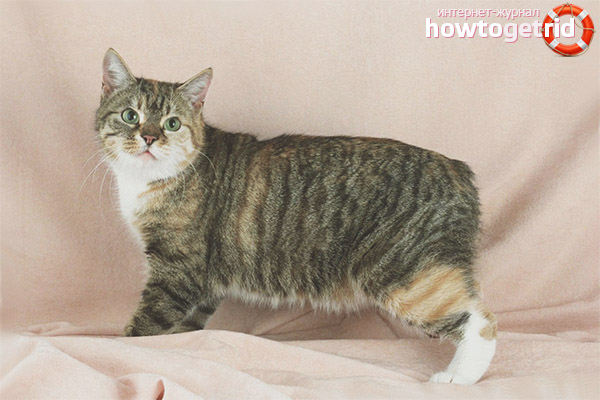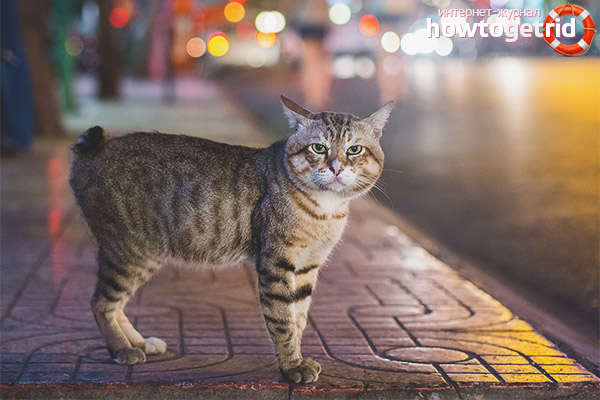The content of the article
Who would have thought that in nature there may be cats that lack a tail. It turns out that this is quite possible in fact. It is by the presence of such a non-standard type of cat that Manx is different from other breeds. Of course, this lies beyond the perceptions that are associated with these animals. It should be noted that some representatives of this breed still have a certain hint of a tail or even the very detail of this cat's pride, but very limited in length.
The history of the breed
There are no reliable facts from where this cat came from, from which regions it reached its contemporaries. It is known for certain that it was first discovered on the Isle of Man. There is no pronounced unity in the data regarding the origin of the cat. According to the official assumption of felinologists, short-haired cats were long-time inhabitants of the island. They noted a certain kinship with modern feline British.
The territorial isolation of the Isle of Man has led to a situation in which the tailless gene has become entrenched. Perhaps her appearance was made possible due to the fact that the Vikings introduced long-haired Scandinavian cats, which were the forerunners. Mention of the breed of cats that did not have a tail has been noted since the 16th century. This was the first breed to be officially registered in the UK. However, for the first time such cats took part in the exhibition, which took place only in 1906. On it as contestants one could see purebred Manks.
Description
The appearance of the representatives of this breed has a certain unique feature. It seems that all parts of the cat's body tend to take the shape of an ideal ball. The standard assumes the following characteristics:
- The eyes are round in shape, with a tendency to tilt slightly towards the base of the ear. A prerequisite is the slanting of the eyes. Color shades can be very different, but there is a good combination in relation to the color of the coat.
- Allowed any colors of the coat, but not outcrossing with a Siamese or Burmese cat, as well as their derivative shades.
- The coat is short, thick and shiny and has a distinctive dense undercoat. Longhair kittens may appear in the offspring.
- The nose is medium sized. No abrupt transitions.
- The ears are rounded, with a wide arrangement.
- The body is medium in size. Within the breed, certain fluctuations are noted, but the mass rarely exceeds 4 kg. The case is solid in nature, characterized by breadth and pronounced development. Menks should be attributed more to stocky than graceful animals. Flatness of the abdomen, curvature of the short back are another characteristics that distinguish this breed.
- Legs are strong and massive. The greater development of the hind legs than the forelimbs is characteristic. For this reason, the croup is located slightly higher than the shoulder girdle. This fact fully explains the manner in which cats move. Most of all they are successful in jumping.
The description would be far from complete, not to mention the main distinguishing feature. These cats have no tail. Some representatives have some semblance of this part even, more precisely, a hint of it. In this regard, there is a whole classification based on the length of the tail. The gene responsible for the presence of the tail is dominant. If mating was carried out in two reference representatives, the gene is able to mutate in four variations:
- Dimple rumpy. Offspring are potentially doomed to a champion title.There is no tail at all. Instead, there is a hollow.
- Riser. The tail is in its infancy. The value can be determined by several vertebrae. These kittens are also highly regarded.
- Stampy. Such cats must be sterilized, since the sign that they transmit is not of a reference nature. The tail is marked by the presence of vertebrae with pronounced tuberosity.
- Tailed. A kitten has a tail from birth.
If you stroke a Manx cat, you will feel a pronounced plush character. This is because double coat is present. Duality is achieved due to the fact that the length of the outer hair is slightly longer than the undercoat. In addition, its tight fit to the body is not noted.
It seems that such cats can neither walk nor run. All their movements are in the form of jumps. The difference between them and the rabbit in this pan is only that the latter does not know how to meow.
Character
Some mistakenly believe that since a cat has no tail, she cannot express her feelings. Nothing like this. Maybe, but how. To demonstrate their emotional mood, nature rewarded them with a whole arsenal of opportunities. Activity, playfulness and mobility - these are the main features of their character.
Such cats do not know how to show displeasure or do it extremely rarely. If the menx is provided with proper care, then we can confidently say that nature has clearly set them in a positive way. Even without a tail, they did not lose the pride that all feline tribes possess. Even such a refined breeding breed retained all the instincts inherent in cats. The game is extremely positive, while demonstrating elements of a specific cat's humor.
Menks will easily accept dogs and children in their flock. After all, they should not worry about the fact that the little man will drag her by the tail. She simply does not have it. They prefer to play not alone, but with the presence of partners in the game. The real find for families with several children will be the acquisition of Manx. Children will definitely not be bored, and the cat himself will be happy with such playful communication.
Health
The presence of historical isolation led to the fact that it was the Manxs who were characterized by various characteristic diseases. These include:
- Manx syndrome. With it, extremely slow spinal growth is noted. Usually these cats do not live more than 4 months. At the time of purchase, close attention is paid to the structure of the pelvic apparatus. Make sure that there are no dystrophic changes associated with the hind limbs.
- Pyoderma of the back of the body. It is not necessary to treat the cat on its own. It must be shown to the veterinarian. Only he is able to make an accurate diagnosis and prescribe the appropriate treatment.
- At a young age, corneal dystrophy can develop. The phenomenon of edema subsequently goes into the development of ulcerative formations with localization on the cornea.
- Spinal hernia of a congenital nature. With her, the limbs are very weak and impaired movement.
In the absence of disease, the average life of the Manks is 12-15 years.
Anyone with plans to mate the Manxes should remember that it is necessary to use a pair of Dimple rumpy and Tailed. In other words, a cat with a tail mates with a tailless animal. This significantly reduces the risk of hereditary diseases.
Puberty is achieved by the third year of life. For one litter, a cat usually brings 4 kittens. There may be more kittens, but this situation is associated with the possibility of complications for the animal. Kittens should be examined by a veterinarian.
Care
Keep the porridge completely uncomplicated, as it is not whimsical. Care measures are not fraught with any difficulties, which can not be said about health, which must be monitored very closely.The main thing in the care is the regularity of hygiene procedures and activities related to combing. Such animals have a dense coat, on which tars often form. The comb in the set of items intended for the care of animals should be required.
It’s enough for Manks to comb weekly, but when the molt begins, the frequency doubles. It is necessary to constantly rinse your eyes, and clean your ears.
The absence of a tail (takes part in the work of the animal’s vestibular apparatus) prevents the cat from falling correctly. Therefore, the consequences of blows when a cat falls are unpredictable. We must ensure that Manx does not climb very high.
Hygiene measures should be permanent, despite the fact that these cats are endowed with natural cleanliness.
Feeding conditions
You can not give such products:
- raw eggs;
- bean culture.
- River fish;
- unbroken fish of marine breeds.
The following products are allowed to be used in food:
- Meat of low-fat varieties.
- Sour milk products.
- Offal.
- Cereal crops.
If dry feeds are chosen as food, then they must be premium.
Price
If someone decides to buy a kitten of the Manx breed, then such a pleasure will cost him 30,000 rubles. Kittens should be purchased only in trusted professional nurseries. But in our country it is still quite difficult to do this, since they still have not paid due attention to this breed. Why this happened is not known, because Manks was kept in his palace by King Edward VII himself.
Video: cat breed Manx












Submit